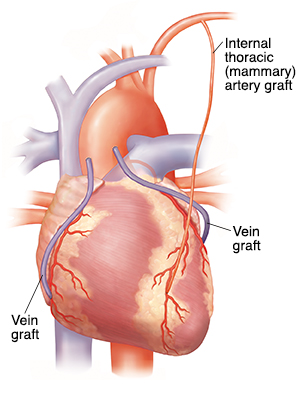Minimally Invasive Bypass Surgery
Minimally Invasive Bypass Surgery
If you have coronary artery disease, coronary artery bypass surgery can help. It creates a new pathway around the blocked part of your artery. This allows blood to flow past a narrowing or blockage in an artery. A healthy blood vessel (bypass graft) from another part of your body is used to create the new pathway. If you have more than one blockage, more than one bypass is done. For minimally invasive bypass surgery, incisions made in your chest are often much smaller than those made for traditional bypass surgery.
Reaching your heart
To get to your heart, the surgeon makes one or more incisions in your chest. He or she makes an incision over your ribs or breastbone. The surgeon then moves the bones apart so that he or she can reach the heart. Depending on the method your surgeon uses, he or she may also make small incisions near your neck and groin. After surgery, the bones are brought back together, and the incisions are sewn up.
Stopping or slowing your heart
Minimally invasive bypass surgery is sometimes done without stopping the heart. The heart is only slowed down with medicines. Then the surgeon uses a special instrument to hold part of the heart still while the graft is sewn on. If your surgeon decides that the entire heart must be stopped, your blood is passed through a heart-lung machine. This machine gives oxygen to your blood and pumps it back through your body. Your heart and lungs take over again once the surgery is done.
Attaching the graft
Bypass grafts are generally from 1 of 3 places in the body. These are the leg, the wrist, or the chest wall. The surgeon first removes the graft vessel from your chest, leg, or arm. Then he or she sews one end of the graft to an opening in the coronary artery below the blockage. If a saphenous vein or radial artery is used, the surgeon sews the other end onto the aorta. If a mammary artery is used, the other end is already attached to a branch of the aorta.
After the surgery
You will usually wake up in an intensive care unit. You will have a breathing tube in place. This will be taken out just after surgery. You also will have an IV in your arm, and other tubes in your neck, wrist, and bladder. You may have a chest tube to drain air or fluid from your chest.
Updated:
March 21, 2017
Sources:
Minimally invasive coronary artery bypass graft surgery: Definitions and technical issues. UpToDate.
Reviewed By:
Fetterman, Anne, RN, BSN,Image reviewed by StayWell medical illustration team.,Mancini, Mary, MD
